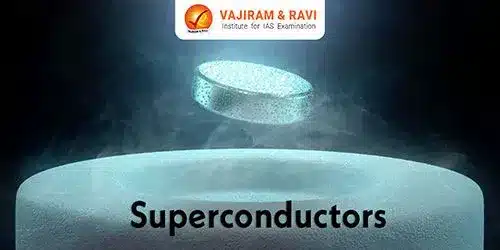Superconductors are materials that conduct electricity with zero resistance when cooled below a characteristic temperature. Also, these materials expel magnetic fields when transitioning to the superconducting state. A normal conductor can become a superconductor when the electrons are paired to “cooperate with a material’s vibrating atom”. The phenomenon of superconductivity was discovered in 1911 by Kamerlingh Onnes.
Superconductors find applications ranging from MRI machines, and particle accelerators to magnetically levitated trains. Ongoing research focuses on raising the operating temperature and developing new high-temperature superconductor materials for various objectives.
History of Superconductivity
One of the most intriguing quantum phenomena, superconductivity was first discovered in 1911. The major milestones in the scientific understanding of superconductors are as follows:
- 1911: Superconductivity was first experimentally observed in mercury by Dutch physicist Heike Kamerlingh Onnes. It vanished electrical resistance at 4.2K temperature.
- 1933: The Meissner effect explained the expulsion of magnetic fields from superconductors' interiors.
- 1957: Bardeen, Cooper and Schrieffer formulated the BCS theory successfully modelling superconductivity in conventional low-temperature superconductors through electron-phonon interactions.
- 1962: Brian Josephson predicted the tunnelling of electron pairs between superconductors separated by an insulating barrier. This Josephson effect enabled the design of ultra-sensitive magnetometers.
- 1986: Georg Bednorz and Alex Müller discovered new ceramic oxide superconductors with remarkably high critical temperatures exceeding liquid nitrogen temperatures.
- 1987: Yttrium barium copper oxide (YBCO) ceramic material was discovered with a superconducting transition temperature of 93K, which is above liquid nitrogen's 77K boiling point.
- 2008: Iron-based high-temperature superconductors were discovered further expanding the range of materials exhibiting this phenomenon.
Principle of Superconductivity
Conventional superconductivity is explained by the formation of electron pairs known as Cooper pairs combined with electron-phonon interactions as conceptualised in the BCS theory:

- Cooper pairs: At sufficiently low cryogenic temperatures, interactions between conducting electrons and crystal lattice vibrations (phonons) cause the lattice to distort slightly.
- This causes some electrons near the Fermi level to become unstable and rearrange into pairs called Cooper Pairs.
- These Cooper electron pairs can move through the metallic crystal lattice without resistance as they do not get scattered by the lattice vibrations.
- Large-scale coherent movement of many such tightly bound Cooper pairs leads to exactly zero DC electrical resistance inside the material.
- The Cooper pairs also induce a weak superconductivity in the rest of the material lattice further reinforcing the effect through a feedback loop.

- Meissner effect: The Meissner effect leads to the complete expulsion of external magnetic flux lines from a superconductor's interior when cooled below the transition temperature.
- This distinguishes superconductors from other types of conductors.
Superconducting Materials
Different classes of materials exhibit superconductivity at different characteristic temperatures. Some that have achieved the highest known superconducting critical temperatures are:
| Material | Critical Temperature | Key Facts |
| Mercury | 4.2 K | - The first superconductor was discovered by Kamerlingh Onnes |
| Niobium-titanium alloys | 10 K | - Used in MRI machines, particle accelerators |
| Niobium-tin | 18 K | - Used in powerful electromagnets |
| Niobium-germanium | 23 K | - Used in NMR spectrometers |
| Ceramic cuprates | 90-130 K | - The first high-temperature superconductors discovered by Bednorz and Müller |
| Yttrium barium copper oxide (YBCO) | 92 K | - Allows high-temperature superconductivity, used in motors |
| Bismuth strontium calcium copper oxide (BSCCO) | 107 K | - High-temperature superconductor, used in wires and tapes |
| Mercury thallium barium calcium copper oxide | 133 K | - Highest critical temperature non-cuprate superconductor |
| Magnesium diboride | 39 K | - Inexpensive material made from magnesium and boron |
| Hydrogen sulfide | 203 K | - Predicted to superconduct at extremely high temperatures under pressure |
| Carbon nanotubes | -240 K | - Superconduct only along their length, not across |
| Graphene | 1.7 K | - Becomes superconducting when coupled with calcium |
| Fullerenes | 33k | - Carbon-based spherical molecules like C60 exhibit superconductivity at relatively high temperatures when intercalated with alkali metals. |
Types of Superconductors
Superconductors can be broadly classified based on their transition temperature and material properties into low-temperature and high-temperature variants:
- Low-Temperature Superconductors (LTS): These include elemental superconducting metals like aluminium, lead, and mercury which exhibit superconductivity just a few degrees above absolute zero temperature.
- These also include weak/low-capacity superconducting alloys made using niobium-titanium, and niobium-tin with transition temperatures well below 30 K.
- LTS is explained well by the BCS theory which models the electron-phonon interactions.
- High-temperature superconductors (HTS): These are made using complex ceramic compounds such as YBCO, and BSCCO, which incredibly show superconducting transition at temperatures between 77-138 K.
- These do not require electron-phonon interactions and Cooper pairing and follow unconventional mechanisms arising from their crystalline lattice structure.
- They offer higher current carrying capacities and magnetic field tolerance compared to LTS. Also, they simplify cooling requirements drastically.
- Unconventional Superconductors: These are also being researched - carbon-based organic compounds, metallic hydrogen etc. that become superconducting upon specific doping or under extreme pressures.
Applications of Superconductors
Some major application areas and benefits of superconductors are:
| Application Area | Benefits |
| Healthcare |
- MRI scanners use superconducting magnets to generate strong magnetic fields required for magnetic resonance imaging in medical diagnostics. - SQUIDs (Superconducting Quantum Interference Devices) are very sensitive magnetometers used in magnetoencephalography to map brain activity. |
| Scientific Research |
- Particle accelerators like theLarge Hadron Collider use superconducting magnets to steer and focus particle beams due to their ability to create intense fields. - High magnetic field experiments in physics rely on superconductors to generate the extremely strong magnetic fields required. |
| Power Engineering |
- Superconducting wires allow the construction of motors, generators, transformers and transmission cables with greater power densities and efficiencies. - Superconducting fault current limiters utilise superconductor properties to limit damage from short circuits in power grids Tokamaks. |
| Transportation |
- Maglev trains use superconducting magnets to levitate train cars and propel them by magnetic forces without physical contact. - Superconducting magnetic levitation and propulsion systems are being researched for futuristic spacecraft concepts. |
| Electronics and Quantum computing |
- Superconducting materials are used to build ultra-fast, low-power quantum computers and sensitive detectors and amplifiers. - Superconducting antennas offer low losses for high-frequency radio waves.
|
| Energy Storage | - Superconducting magnetic energy storage (SMES) offers large-scale energy storage with rapid charge/discharge, using magnetic fields in superconducting coils. |
| Industrial processing |
- Magnetic separation techniques utilise superconducting magnets to sort materials. - Superconducting bearings allow frictionless, levitating rotation. |
| Monitoring | - SQUID magnetometers are ultra-sensitive detectors of magnetic fields used in science, medicine and geomagnetic surveys. |
| Defence |
- Degaussing systems use superconducting coils to cancel ships' magnetic fields as protection against mines. - Superconductive shields block electromagnetic pulses and radiation. |

Challenges with Superconductors
Some major technical and economic challenges exist in harnessing superconductors for practical applications:
- High operating temperatures: Superconductors face challenges in achieving high critical temperatures, as conventional superconductors require extremely low temperatures.
- Researchers are developing high-temperature superconductors (HTS), like cuprate superconductors like YBCO, which can operate at higher temperatures, such as -181°C.
- Fabrication and scalability: Superconducting materials face challenges in fabrication and scalability due to complex manufacturing processes like.
- Thin film deposition and wire fabrication, can be expensive and time-consuming, especially for high-quality wires using materials like REBCO.
- Material defects and stability: Superconductors are sensitive to defects, impurities, and structural instabilities, which can degrade their properties and reduce critical current density.
- Researchers are exploring ways to mitigate these challenges through defect engineering and material stability improvement.
- Cost and commercialisation: Superconductors, particularly high-temperature ones, can be costly to produce and commercialize due to raw materials, fabrication techniques, and cryogenic cooling systems.
- However, advancements in manufacturing processes and cost-effective production methods are being pursued to overcome this challenge.
- Integration and compatibility: Superconductors can be integrated into existing systems, requiring careful consideration of electrical insulation, thermal management, and mechanical stability to ensure compatibility with other materials and technologies.
Superconductors in India
India has proactively furthered superconductivity research and developments with noteworthy indigenous contributions:
- National Superconductivity Mission: It was launched in 2017 by the government to develop indigenous superconductors and their applications in various industries,
- Focusing on fundamental research, advanced materials, collaboration, technology transfer, and creating a skilled workforce.
- Local manufacturing of MRI machines: Indian scientists have successfully built the country's first MRI machine superconducting magnet domestically.
- This aligns with national self-reliance goals in high-end medical equipment.
- Nuclear fusion progress: Sub-systems for fusion reactors relying on superconductivity are being developed locally via initiatives like the Steady State Superconducting Tokamak.
- High-temperature superconducting transformer: BHEL has indigenously developed India's first transformer using cutting-edge High-Temperature Superconductor technology through R&D efforts.
- International collaborations: Indian institutions are engaged with CERN for the Particle Physics project PIP-II, focusing on designing novel superconducting and room-temperature magnets.
Last updated on December, 2025
→ Check out the latest UPSC Syllabus 2026 here.
→ Join Vajiram & Ravi’s Interview Guidance Programme for expert help to crack your final UPSC stage.
→ UPSC Mains Result 2025 is now out.
→ UPSC Notification 2026 is scheduled to be released on January 14, 2026.
→ UPSC Calendar 2026 is released on 15th May, 2025.
→ The UPSC Vacancy 2025 were released 1129, out of which 979 were for UPSC CSE and remaining 150 are for UPSC IFoS.
→ UPSC Prelims 2026 will be conducted on 24th May, 2026 & UPSC Mains 2026 will be conducted on 21st August 2026.
→ The UPSC Selection Process is of 3 stages-Prelims, Mains and Interview.
→ UPSC Result 2024 is released with latest UPSC Marksheet 2024. Check Now!
→ UPSC Prelims Result 2025 is out now for the CSE held on 25 May 2025.
→ UPSC Toppers List 2024 is released now. Shakti Dubey is UPSC AIR 1 2024 Topper.
→ UPSC Prelims Question Paper 2025 and Unofficial Prelims Answer Key 2025 are available now.
→ UPSC Mains Question Paper 2025 is out for Essay, GS 1, 2, 3 & GS 4.
→ UPSC Mains Indian Language Question Paper 2025 is now out.
→ UPSC Mains Optional Question Paper 2025 is now out.
→ Also check Best IAS Coaching in Delhi
Superconductors FAQs
Q1. What is a semiconductor?+
Q2. How are semiconductors different from conductors and insulators?+
Q3. What are the different types of semiconductors?+
Q4. What is doping in semiconductors?+
Q5. How are p-n junctions formed in semiconductors?+
Tags: quest superconductors

















